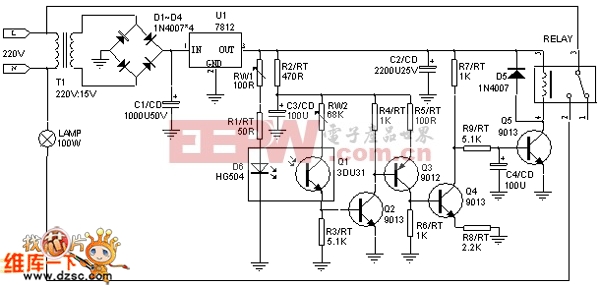First, the working principle
When the power is turned on, the infrared light-emitting diode D6 begins to emit infrared light. This light illuminates the photosensitive transistor Q1, causing it to enter a low-resistance state. As a result, the base of transistor Q2 is pulled high, turning Q2 on. This in turn activates Q3 and Q4. However, when Q4 is conducting, the base of Q5 is held at a low level, keeping Q5 off and the relay inactive.
When a person or object interrupts the infrared beam from D6, Q1 quickly switches to a high-impedance state. This causes Q2, Q3, and Q4 to turn off, allowing Q5 to conduct. As a result, the relay is activated, and the bulb lights up. Once the person moves away, the infrared beam is restored, reactivating Q1. This causes Q2, Q3, and Q4 to turn back on, which stops Q5 from conducting. The relay then releases, and the bulb turns off.
The delay before the bulb turns off is controlled by capacitor C4, which discharges over time. This ensures that the light remains on for a short period after the person has left.
Second, component selection
For the infrared LED D6, the HG504 model is recommended. It operates at a current of 200mA and has an optical output power of 40–50mW, allowing a control range of approximately 8 meters. If the required control distance is shorter than 5 meters, the HG410 series can be used instead.
As for the phototransistor Q1, options like 3DU31 or 3DU5 are suitable. These transistors are sensitive to infrared light and provide reliable operation in this circuit.
After assembling the circuit correctly, it's time to perform the debugging process. Start by disconnecting the base of Q4 from the circuit. Adjust the variable resistor RW1 so that the current through D6 is around 150mA. Ensure that Q6 and Q1 are positioned close to each other. At this point, Q2 and Q3 should be conducting.
Next, adjust RW1 so that the voltage across R1 is nearly equal to the supply voltage. Then slowly increase the distance between D6 and Q1, depending on the width of the area you're controlling. Always make sure that D6 is aligned with Q1. At this stage, Q2 and Q3 should remain on. If not, you can slightly adjust RW1 to increase the current in D6, but never exceed 200mA.
You can also adjust the resistance of RW2 to ensure that Q2 and Q3 are properly turned on. Once everything seems stable, reconnect Q4 to the circuit. Test by blocking the infrared beam between D6 and Q1. Q5 should activate, and the relay should respond accordingly. This confirms that the circuit is working as intended.

Fiber Optic Splice Closure
Fiber Optic Splice Closure,Fiber Optic Splice Case,Fiber Splice Closures,Outdoor Fiber Optic Splice Closure
Cixi Dani Plastic Products Co.,Ltd , https://www.danifiberoptic.com
